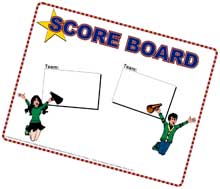How can Mrs. Nash implement these activities?
Page 11: Assign Pairs to Teams
Although Mrs. Nash would like for each of her students to possess an intrinsic motivation to read, she understands that a number of them lack the necessary skills and self-confidence. For this reason, she is excited to learn that PALS incorporates an extrinsic motivator—a friendly classroom competition in which pairs are assigned to one of two teams and earn points through participation. As Mrs. Nash prepares for this competitive component of PALS, there are several things she should be sure to consider.

Green
Team

Red
Team
Assigning Students to Teams
To the extent possible, teachers should make certain that their teams are matched in ability. They should create new teams approximately every three to four weeks to coincide with the assignment of students to new pairs. If there is an uneven number of pairs on the teams, the teacher can:
- Assign the pair to one team and average each team’s scores (i.e., the total number of points earned, divided by the number of pairs)
- Add one pair’s points to both teams’ scores
Awarding Points
In general, a student earns points during PALS sessions for correctly completing each activity and for working well with his or her partner. At the end of each week, the scores for each team can be tallied, and the first- and second-place winners announced and posted on the Score Board.
The table below outlines the points that student pairs can receive for each of the three reading activities.
| Activity | Possible Points Earned |
| Partner Reading |
|
| Paragraph Shrinking |
|
| Prediction Relay |
|
In addition to assigning points for each activity, the teacher may also allot bonus points (one or two, perhaps) to those students who are doing a better-than-average job at reading or working cooperatively. When doing so, the teacher should be sure to let the students know why they are receiving the points. The teacher can announce who has earned bonus points during transition times, thus signaling to other students that they need to work on certain aspects of their reading or social behavior.
For Your Information
Because points are often awarded for correctly completing reading activities, higher-performing students often earn more points than do their lower-performing counterparts. It is important that the teacher emphasize that students should strive to increase their own scores rather than compete with their peers.
Materials for the Competition
Few materials are needed for the classroom competition. The teacher will need to create a Pairs and Teams Assignment Chart, like the one posted on Mrs. Nash’s bulletin board, so that students can keep track of their partners and their teams. The teacher will create new charts every three to four weeks when pairs and teams are reassigned. Each student pair will require one Score Card per week to keep track of the points they’ve earned. Once the students have reported their points for the week, the teacher will post the scores on the Score Board and announce the first- and second-place winners. Click each of the images below to view printable versions of each resource.


